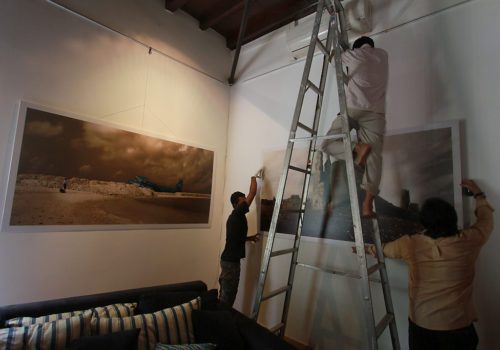Photographs by Phan Phearith and Uy Nou Sereimony.
Climate change is real. The rainy reason lasted until November 27, one day after the opening of the Photo Phnom Penh festival, even though it was a late opening date in the festival’s history. Now it’s hot, too hot for the season during the day, but the evenings are lovely.
As usual, doubts persisted up to the last moment regarding the availability of exhibition spaces, including the Grande Galerie in the Université Royale des Beaux-Arts, the site of the festival’s 5th anniversary exhibition, which featured the work of 76 photographers—a third of them Cambodian—who have participated in the festival since 2008. Stress levels dropped once we got last-minute permission to use the spaces. We just had to wait for some unscheduled construction to finish before hanging the exhibition’s 100 photographs. The captions were put in place only a few hours before the opening.
Georges Rousse arrived early. Having already produced two visual works in 2008 during a residency in the Cambodian capital at the invitation of the French Cultural Center, he used a typical 1970s building as the site of his installation, and the magical red squares and circles served as a wonderful and striking anniversary logo for the festival, covering the walls of the Embassy of France. As soon as it was installed, the local tuk-tuks and motodops paused to contemplate the colorful architectural illusion, slowing the incessant flow of traffic.
The same was true on the Quai Sisovath. The three large walls featuring the works of three different artists: Isabel Munoz, with a series on the Royal Ballet of Cambodia; Adrian Fernandez Milanes, with a humorous work of decorative artificial flowers and fruits from his native Cuba; and pictures of a role-playing game created by Dareth Rosaline, who asked men, women and children of all ages to wear a dress with orange and black stripes. In the cooler moments of the day, families and groups of young people commented on the work and laughed out loud at what they saw. In the hotter hours, it was mainly tourists taking pictures in front of the installations.
JR’s Inside Out project slowly took over Phnom Penh, getting its citizens and the city itself involved, from chic spots like the beautiful hotel La Plantation to the more working-class neighborhoods near the old Catholic church, from the small lanes reminiscent of a village to the children of the NGO ASPK, who had a great time. Appearing in black-and-white against a dotted background, the people of the city embraced this part of the festival, even if they did not visit the exhibitions.
When you add in Clément Briend’s magical nighttime projections on the trees and walls of Phnom Penh, it became clear that the festival is a truly public event, gaining the trust of the city authorities who have to agree to every installation. (It might take them a while, but they do it.)
In the private spaces that always welcome us so generously, Europeans and Asians accept their separate styles and the differences that make them complementary. This dimension was particularly visible at the Université Royale of Phnom Penh in the ample and elegant “Dome” designed by Van Molyvan, the site of six exhibitions. The choice is strategic; the mediators welcomed the nearly 19,000 students of the campus, answering their questions.
Due to the three months of royal mourning following the death of Norodom Sihanouk (whose cremation will not be held until February 4), we were unsure how much we would be able to operate in public spaces. We were especially worried about our “picture boats” that must necessarily pass by the Royal Palace, which holds the remains of the former head of state
of the father of the country’s independence. We were very committed to the boats because they form an integral part of the identity and magic of the festival. In the end, they were only allowed, for budgetary reasons, to sail along the banks of the Tonlé Sap on two nights only, December 7 and 8. In order to share in the mourning of the Cambodian people, who come to sign the books of condolences at the palace, and parade in organized groups before the catafalque, the first boat responded to this current event with the work of three photographers: Kim Hak, John Vink and Philong Sovan. (One conspicuous and unfortunate absence was French President François Hollande, who was less than an hour away in Vientiane. .)
We will wait for the two million people expected to attend the cremation ceremony, which will take place on an imposing pyre erected between the Palace and the National Museum, while the young people will flock to pay tribute with offerings, it seemed important to note that we acknowledged the emotional state of the country, and that photographers were there to bear witness.
Christian Caujolle
Photo Phnom Penh festival
From December 8 – 13, 2012
Phnom Penh
Cambodia
















